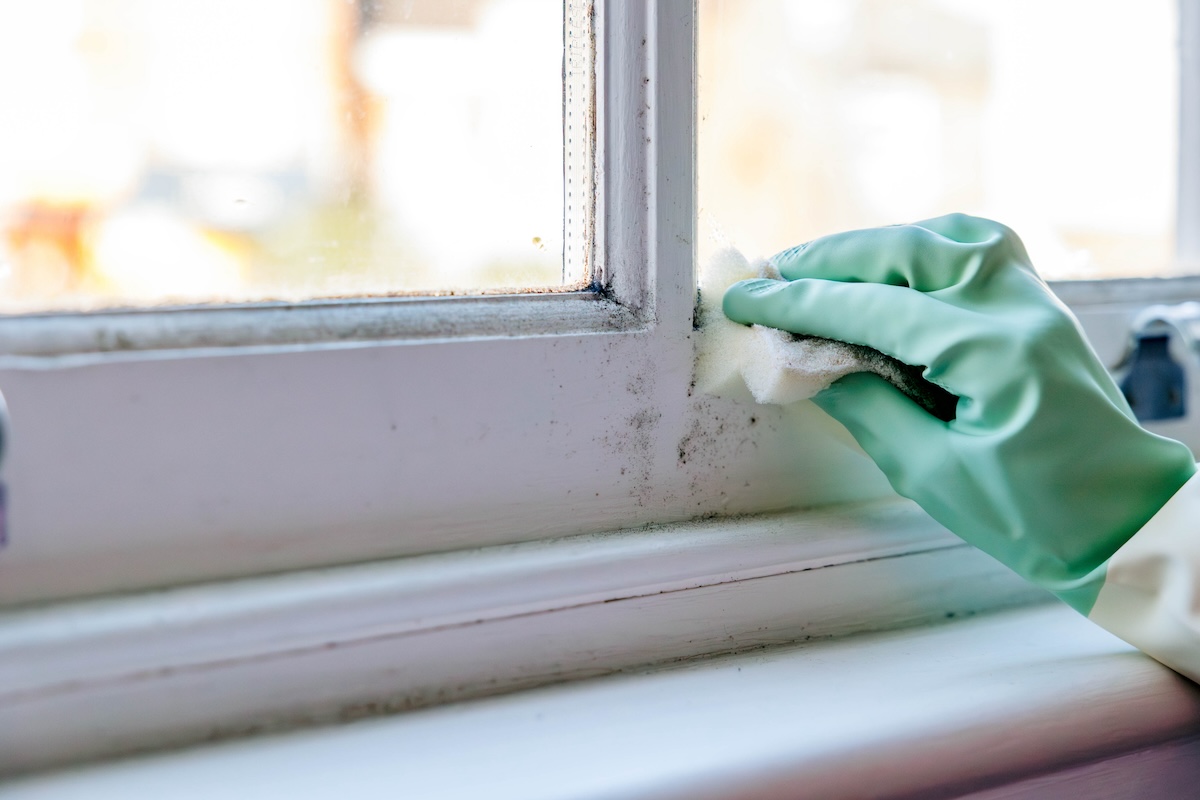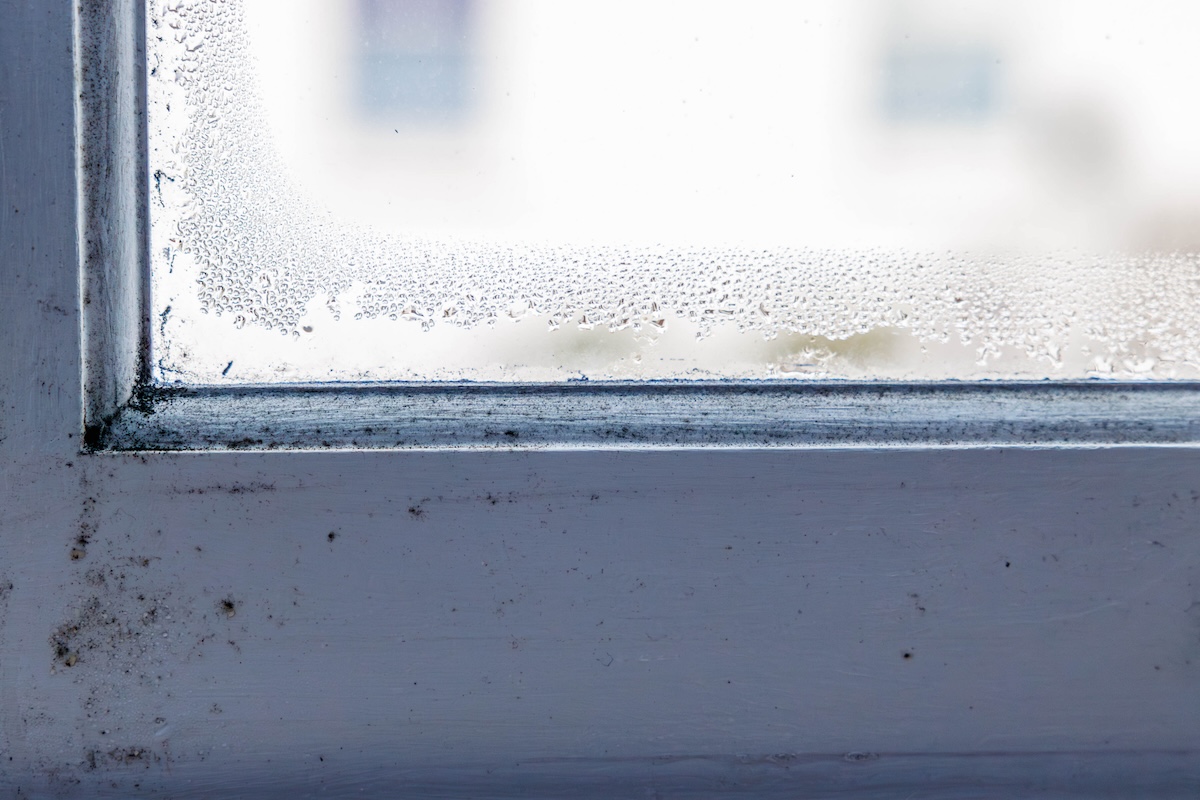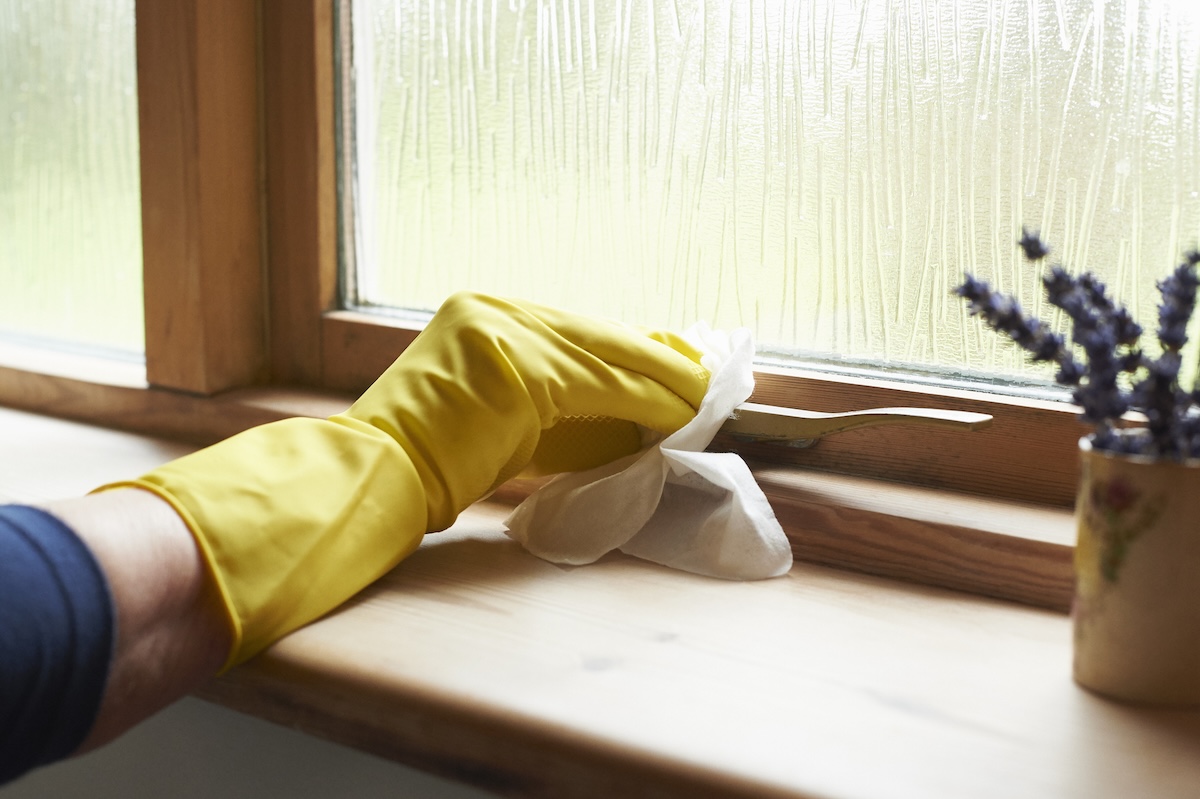

We may earn revenue from the products available on this page and participate in affiliate programs. Learn More ›
Mold is a common problem on windowsills in many homes. That’s because as warm humid indoor air hits the cool window pane, condensation forms on the sill, creating the moist conditions necessary to foster mold or mildew growth. This is especially true during winter months, when indoor air temperatures are significantly warmer than outdoor temperatures.
Not only is that mold unpleasant to look at, it can also be hazardous to your health. The more dangerous black mold can cause serious health problems if it’s inhaled. If you catch mold growth around your windows early, you can clean it easily using products you probably already have under your kitchen sink.
What causes mold on windowsills?

There are three basic requirements for mold to take hold on your walls, windowsills, or anywhere else for that matter, says Russell Vent, vice president of Paul Davis Restoration of Greater Rochester, N.Y. According to Vent, it requires “mold spores, oxygen, a food source (some sort of organic material for mold to grow or feed on) and water or moisture.” Mold spores are present in just about every environment, he says, and dust and dirt built up on the sill satisfies the food-source requirement. There are a couple of ways for moisture to form, creating mold or mildew:
- Condensation: When the mercury drops outside, warm indoor air causes humid air to condense on the window panes and sill. This is especially true with single-pane windows that transfer cold outdoor air temperatures indoors more easily than double-pane windows. Mold on windows from condensation is also prevalent in rooms with humid air, such as bathrooms and kitchens.
- Leaks: The other way moisture can end up on your windowsill is through a leak in the seal around the sill or a cracked pane, both of which can allow moisture from rain and snow to get inside.
What kills mold?
While cleaning mold off porous surfaces can be a challenge, removing mold from nonporous surfaces is easier. “If you have visible growth on semi-porous building materials or low-porosity materials, cleaners like a peroxide-based cleaner and some scrubbing and elbow grease can usually be a good solution to the problem,” Vent says. Here are your best options:
- Bleach: When most people see mold, they reach for bleach. But while bleach does a great job of killing surface mold, it doesn’t penetrate deeply into surfaces. In other words, bleach is not effective at taking out the mold’s roots, meaning the mold will probably return. Since most windowsills are painted with semi-gloss paint, which is nonporous, bleach should eliminate the problem if the paint is in good condition.
- Vinegar: Household vinegar is perhaps the best weapon for how to remove mold from a windowsill. It kills most mold species, including black mold, and penetrates to the roots, taking it out completely. Use undiluted household vinegar with 5 percent acidity.
- Hydrogen peroxide: A 50/50 solution of hydrogen peroxide and water is also an effective solution for killing mold. While it doesn’t penetrate porous material well, it’s effective on nonporous surfaces.
- Commercial products: If you’re looking to buy a product with industrial-strength mold-killing power, there are several that will do the trick. Two of the best are RMR-86 Instant Mold and Mildew Stain Remover Spray and 30 SECONDS Pro Mold and Mildew Stain Remover.
Before You Begin
Mold poses a potential health hazard, especially if you’re dealing with black mold on a windowsill. Vinegar, bleach, peroxide, and other cleaning supplies can also be dangerous. Take precautions to protect yourself from both mold and the supplies you are using to clean it. Mold is especially harmful when you breathe in spores, so wear an N-95 respirator (or at least an N-95 half mask), along with gloves and goggles, while you work.
Tools & Materials
Bobvila.com may earn a commission from purchases made through these links.
How to Kill Mold on Windowsills

Cleaning mold off a windowsill is a relatively easy process that involves basic tools and a little elbow grease.
Step 1: Wipe down the windowsill.
Make sure the area is dry before you begin by wiping it down with a rag or paper towels. Since you’ll be wiping up mold along with the moisture, use something that’s disposable.
Step 2: Spray cleaning solution.
When cleaning mold off a nonporous surface, several options work. Vinegar, bleach, or hydrogen peroxide-based solutions are all effective at killing and removing mold from a windowsill. Start by coating the mold with the solution using a spray bottle. Let the solution soak in for about 10 minutes.
Step 3: Scrub mold with a brush and cleaning solution.
Use a stiff-bristle brush to scrub the cleaning solution into the mold. The goal is to expose all the mold to the cleaner while physically detaching it from the sill. After scrubbing the mold loose, wipe the sill clean with a disposable rag or paper towel, so you don’t have to worry about cleaning and sanitizing these supplies afterward.
Step 4: Let the windowsill dry completely.
Allow the windowsill to dry, then examine it to determine if any mold remains. If so, you’ll need to repeat the cleaning process or the mold will grow back.
How to Prevent Mold on Windowsills

Preventing mold is as important to know as how to kill mold. Since mold thrives in conditions in which the humidity is above 55 percent, ventilation and keeping water out are key to prevention.
- If the problem is with a bathroom window, make sure to use the bathroom fan when showering to prevent mold on the ceiling, windowsill, or other surfaces.
- If the fan isn’t reducing condensation, consider upgrading to a more powerful bathroom fan.
- You also can help eliminate mold spores with an air purifier.
- If the problem is a leaky window, replace the window or repair any broken panes, gaskets, or seals that allow rain to get inside and form mold on the window frame or sill. If the window isn’t repairable, you’ll need to replace it.
- Discourage mold growth on your windowsills by coating them with mold-resistant paint. We recommend Zinsser Perma-White Mold & Mildew-Proof Semi-Gloss Interior Paint, which comes with a 5-year mold and mildew-proof paint film guarantee.
When to Call a Professional for Mold Removal
While removing small amounts of mold on a windowsill is something you can handle safely and effectively using the methods and practices above, you might have to move on to stronger cleaners and more intensive cleaning (or professional help) to address mold that has penetrated a porous windowsill.
Larger mold problems require the expertise of a professional to test for mold and remove it. According to Vent, if the mold growth is greater than 10 to 15 square feet, you’ll want to call in a pro. He also suggests hiring a mold removal company if you have serious mold sensitivities, asthma, or a compromised immune system.
